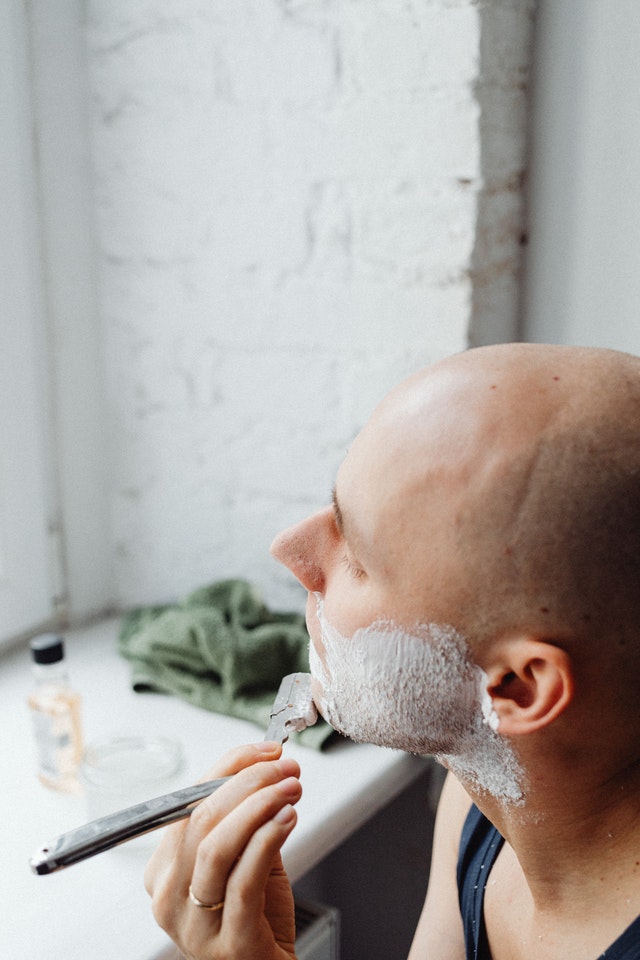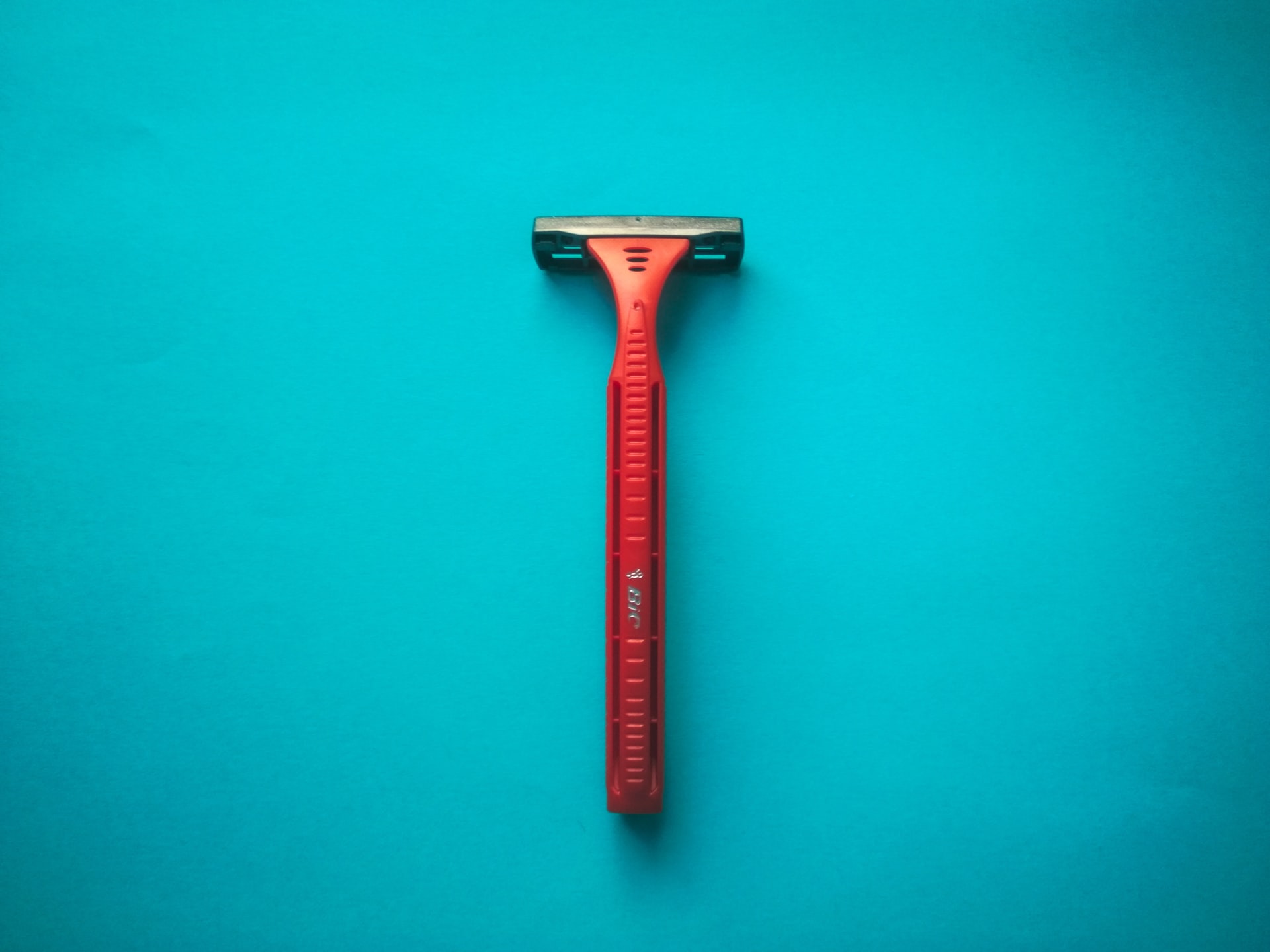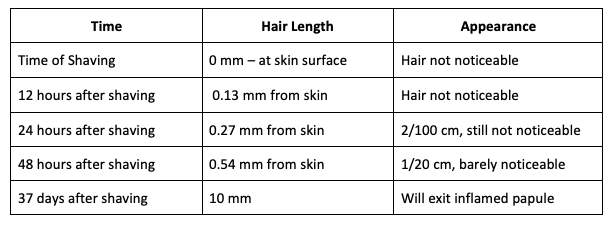Razor bumps can be a bother. When they show up, you want them gone fast.
Also known as pseudofolliculitis barbae, razor bumps are small red bumps that can occur after shaving. They make your skin look bumpy and feel irritated. When left alone to heal and given proper skincare, razor bumps typically last for about 2-3 weeks. However, severe cases can go on for months.
Razor bumps are a common problem for men who shave their faces regularly, but they can affect women too. In this article, we’ll take a look at what razor bumps are, how to get rid of them, how long they last, and most importantly: how to prevent them from popping up in the first place. Read on to learn more!
After shaving, you may have seen these bumps on your face or neck and wondered how long they’d last. Razor bumps can be frustrating. These ingrown hairs can range from mildly irritating to extremely painful and unsightly.

Razor bumps are caused by ingrown hairs (also called pseudofolliculitis barbae), which develop when hair shaves off unevenly and curls back into the skin instead of growing out the way it should. Mild cases of razor bumps will resolve in one to two weeks. Unfortunately, more severe cases may take much longer to heal. Sometimes, razor bumps cause permanent scarring that does not go away. The resulting irritation looks like small pimples that don’t go away with time or regular cleaning.
Luckily there are steps you can take to reduce razor bumps.
If you want to prevent razor bumps, here’s what you need to know:
Folliculitis is a skin condition resulting from ingrown hairs. It’s caused by shaving, which damages your hair follicles, making it easier for bacteria to grow inside them and cause inflammation.
Ingrown hairs are common in the armpits, groin area and face due to these areas being shaved most often. The inflammation and redness present on the skin may last for up to two weeks until the hair falls out or grows back in its natural direction, which will leave you feeling smooth again!
Common causes of razor bumps include shaving too close to the skin and using blades that cut too closely. Razor bumps can also result from shaving in the direction the hair grows. Shaving in this way leaves behind tiny hairs, which then become ingrown hairs when you attempt to push them back out through subsequent shaves. To avoid this, try shaving in the opposite direction of your hair growth (against it).
When it comes to how long razor bumps last and how they’re treated, there are a few factors at play:
If you take care of your skin and protect it from further injury, razor bumps will heal in 2-3 weeks.
You can prevent razor bumps by selecting the right razor and using proper shaving techniques.
The best method is shaving in the direction of hair growth. Avoid using dull razor blades with too much pressure or shaving in one direction without changing your angle after every stroke.
You should also leave your hair alone for long periods to avoid irritation. Trimming or shaving only when necessary will also help reduce irritation by preventing overgrowth of ingrown hairs and keeping the area from becoming irritated from constant grooming.
As you can see, there are many ways to prevent razor bumps from happening. If you follow these tips and strategies, you will be able to avoid razor bumps with ease.
It is important to note that every person’s skin is different, and what works for one may not work for another. You should try out different methods to find one that works best with your skin type and hair texture.
The best treatment for razor bumps is exfoliation and pushing hairs out of the skin through trimming or shaving only when necessary.
Exfoliating your skin will help remove dead skin cells that can irritate and reduce ingrown hairs.
Try using an over-the-counter exfoliant cream for sensitive skin.
If razor bumps persist, you need to talk to a doctor about your skin condition.
You can avoid razor bumps if you’re conscious of how you shave.
Hopefully, you better understand razor bumps and what to do about them. To keep razor bumps from sticking around for two to three weeks, you should try to prevent them altogether. Be sure to follow these simple steps for a safe shave.
Disclaimer: The contents of this article are for informational purposes only and do not constitute medical advice. The information, graphics, and images on this site are not intended to substitute diagnosis or treatment by a medical professional. Always seek the advice of a licensed physician for any questions you may have regarding a specific condition.
Razor bumps are uncomfortable. If you have this unfortunate skin rash from shaving, you probably wonder how long razor bumps last.
It is tough to say how long razor bumps last because each case is different. In general, a true case of razor bumps, also called Pseudofolliculitis Barbae (PFB), can last one month or more. Factors such as how the skin is cared for and what products are applied can affect the healing time for razor bumps.
If you’re wondering why skincare matters when it comes to healing razor bumps, and what you can do to get the problem to go away faster, you are not alone. Read on to learn more.

Razor bumps, or PFB, are caused by the natural process of hair growth when it is interrupted by shaving for hair removal. Most commonly PFB occurs on the face and neck but can affect other parts of the body, such as the underarms or thighs. To understand how long razor bumps last, let’s look at how razor bumps begin. It all starts with hair growth.
Hair growth begins with the anagen phase. That is the “growing” phase. During this time, a matrix of cells rapidly multiplies under the skin. This process pushes the older cells of the hair strand out from the skin’s surface. According to the American Academy of Family Physicians, 85 to 90 percent of hairs are in this anagen phase. The remaining hairs are in stages of rest when hair eventually dies or falls out. Hair growth is what causes razor bumps to appear in the first place.
After shaving, facial hair begins to regrow. Sometimes, hairs can curl and regrow in the wrong direction. According to the American Osteopathic College of Dermatology, when body hair, such as a beard, curves and tries to grow back into the skin, the body responds with inflammation and a foreign body reaction. Swollen, reddened, painful bumps appear on the skin as the hair grows. As you can see from the chart, it may take a few days for razor bumps to show up after shaving.
Post-shave razor bumps can also appear as:
These bumps may also bleed easily and can become infected. In some cases, you might see hairs trapped under the skin’s surface. These are called ingrown hairs. These signs indicate a case of razor bumps that will go on if the is responding to the trauma.
Studies show that razor bumps usually go away on their own when you stop shaving.
Hair growth patterns vary depending on a person’s age, sex, and genetics. The average man’s beard grows about 0.27 mm every 24 hours. Consider this timeline.

If left to grow to a length of approximately 10 mm, the entrapped hair will exit the inflamed pocket. In other words, the hair will work its way out of the skin. This growth typically takes approximately five weeks, or 37 days, when growing at 0.27 mm per 24 hours.
Another option is to remove ingrown hairs mechanically. For example, tweezing is one method to remove hairs that have grown back into the skin.
On the other hand, if shaving continues, skin damage can worsen. So will the case of razor bumps. In this case, the skin will continue to respond with inflammation. Signs and symptoms will worsen. Over time, a prolonged inflammatory response can cause a condition known as post-inflammatory hyperpigmentation. It is a type of skin discoloration that is worse in darker skin types. PFB can also lead to permanent scarring. If you have hyperpigmentation, a doctor can recommend over the counter treatments to lessen the appearance of dark spots.
If you have razor bumps, you don’t have to wait for them to go away on their own. Most cases of razor bumps will improve faster with a few simple steps you can take at home. The keys to speed healing are to lower inflammation and to prevent infection. Here are a few steps that can do just that.
1. Wash your clothing thoroughly. That means cloth masks over the face or clothing worn over other body parts. Clothes collect dead skin cells and bacteria that could cause inflammation or infection if worn over skin affected by razor bumps.
2. Cleanse the area with gentle antibacterial soap. Avoid reusing washcloths or using body poufs. Using a clean cloth each time will prevent bacteria from irritating skin more.
3. After cleaning the skin, apply a moisturizer to the area. Lotions and creams with salicylic acid can also help symptoms.
4. Consider over-the-counter products to reduce inflammation and prevent infection. Some of these options include antibiotic ointment or hydrocortisone cream. Natural plant-based and herbal remedies such as tea tree oil or witch hazel calm aggravated skin.
5. Avoid further irritation. Avoid shaving the area again until the bumps go away. When razor bumps are in the face or neck areas, it might be necessary to grow a beard. While the hair is growing, keep the hair clean to prevent skin infection.
You should see a medical professional when razor bumps don’t go away. If you try these steps to soothe the skin, but your signs and symptoms become worse, a doctor should evaluate your razor bumps.
If you stop shaving, but the bumps do not resolve in 4-5 weeks, a healthcare provider should evaluate the skin condition. Some cases might require medication, prescription cleansers, special creams, or other treatments.
While it’s true that severe cases of razor bumps can cause permanent skin damage, don’t jump to that conclusion right away if you are worried about stubborn bumps that just don’t go away, make an appointment to talk with a healthcare provider.
Now that you know how long razor bumps last and what causes them use these tips to get rid of bumps faster. And when home care doesn’t work, talk to your doctor.
Disclaimer: The contents of this article are for informational purposes only and do not constitute medical advice. The information, graphics, and images on this site are not intended to substitute diagnosis or treatment by a medical professional. Always seek the advice of a licensed physician for any questions you may have regarding a specific condition.